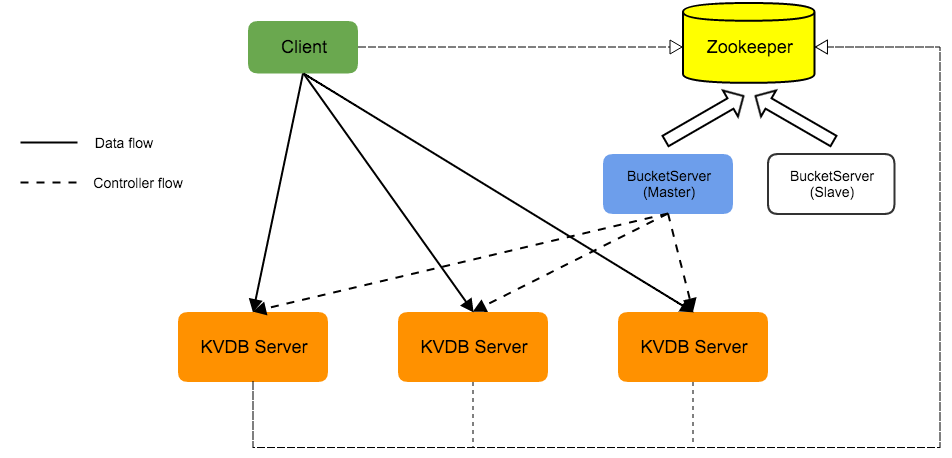KVDB is key value store has persistent database engine and supply cluster feature. KVDB consist of one BucketServer and many KVDB instance node . BucketServer manage keys hashed location and KVDB instance node alive or meta information just like a cluster router. and role as master of the cluster. KVDB instance node s store datas' in its storage engine like Redis or Memcached in memory write(set) and query(get) and write with ahead log (WAL log), KVDB has high performance with multi-threads(benefit from Go routines). you can using KVDB cluster just as one single big memory instance node .
- Key value data struct based
- Data persistence with WAL log
- **Cluster with BucketServer and KVDB instance node **
- key max length is 250 (defined by MAX_KEY_LENGTH)
- value max length is 8MB (defined by MAX_ITEM_LENGTH)
| command | usage | description |
|---|---|---|
| set | set key value | save one key |
| setex | set key 30 value | save one key with expire time |
| setnx | set key value | save one key only if it doesn’t exist |
| mset | set key1 value1 key2 value2 | save multi keys |
| cas | cas key old_value new_value | compare and set one key |
| get | get key | read one key |
| mget | mget key1 key2 | read multi keys |
| exists | exists key1 key2 | check if the key exist |
| persist | persist key | disable expire on specified key |
| expire | expire key 30 | set expire time in seconds |
| pexpire | pexpire key 30000 | set expire time in milliseconds |
| ttl | ttl key | get expire time in seconds from key |
| pttl | pttl key | get expire time in milliseconds from key |
| randomkey | randomkey | randomly return one key |
| append | append mykey abcdefg | append value of exist key |
| prepend | prepend mykey abcdefg | prepend value of exist key |
| incr | incr mykey | incr numerical key |
| incrby | incrby mykey 1 | incr numerical key by number |
| decr | decr mykey | decr numerical key |
| decrby | decrby mykey 1 | decr numerical key by number |
| getset | getset key value | get and set key new value |
| del | del key | delete exist key |
| command | usage | description |
|---|---|---|
| save | save | flush all dirty keys to disk that all in memory |
| bgrewrite | bgrewrite | rewrite WAL log (redolog) in background |
| flushall | flushall | delete all items |
| stats | stats | prints server statistics |
| version | version | prints server version |
| ping | ping | return pong |
| error | error | return last error of current session |
- data value location every key is hashing to its owner KVDB instance node . A single key only and only if belongs to single KVDB node exactly.
- virtual bucket
RangServer divide all hash into virtual bucket slots called
vbucket.
slot = hash(key) % vbucket.size() kvdb_node = vbucket[slot].KVDB value = kvdb_node .get(key)
-
more detail of vbuckets algorithm please read https://github.com/gugemichael/kvdb/blob/master/tools/vbuckets.py
- memory pool use slab chunk
- only for values store without keys
- disk operation write() with append only
- periodic make rewriting of WAL log. could reduce recovery overhead
- flush policy configable :
- flush request keys before respond to client (every request)
- flush accumulated keys every second
- flush accumulated period dirty keys that time has passed MAX_DIRTY_TIME
- flush accumulated period dirty keys over MAX_DIRTY_KEYS
- flush synchronic every key on memory usage ratio has over MAX_DIRTY_RATIO
- only doing recover when server restart
- there has a switch of servicing for client in recover processing or not
- **replay commands in WAL **

